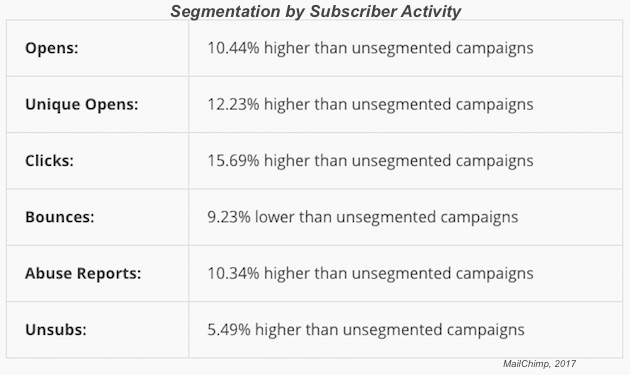Segmented email campaigns have, on average, significantly higher open and click rates—and significantly lower bounce, abuse, and unsubscribe rates—than non-segmented campaigns, according to recent research from MailChimp.
The report was based on data from 11,000 segmented campaigns sent by 2,000 MailChimp customers to nearly 9 million recipients. The researchers compared the performance of each brand's segmented campaigns with the performance of that same brand's non-segmented campaigns.
Segmented email campaigns have higher average open rates (+14%), unique open rates (+11%), and click rates (+101%) than non-segmented campaigns sent by the same brands, the analysis found.
Campaigns that are segmented have lower average bounce rates (-5%), abuse report rates (-4%), and unsubscribe rates (-9%) than those that are not segmented.

Below, additional key findings from the report.
Segmentation by Merge Field
Segmentation by merge field (e.g., customer type, ZIP code, job title) is the most popular type of email list parsing by MailChimp customers.
Click rates for campaigns sent to lists segmented by merge field are significantly higher (+55%) than click rates for non-segmented campaigns sent by the same brands.

Segmentation by Interest Groups
Email campaigns sent to lists that are segmented by interest (e.g., a grouping a consumer self-selects, such as favorite music genre), also have significantly higher click rates (+75%) than email campaigns sent to lists that are not segmented.

Segmentation by Subscriber Activity
Email campaigns sent to lists that are segmented by subscriber activity (e.g., the most-engaged or least-engaged members of a list) have lower average bounce rates (-9%) than unsegmented campaigns, but they have higher average abuse report (+10%) and unsubscribe (+5%) rates.

About the research: The report was based on data from 11,000 segmented campaigns sent by 2,000 MailChimp customers to nearly 9 million recipients. The researchers compared the performance of each brand's segmented campaigns with the performance of that same brand's non-segmented campaigns.




